For the past two years, just about every Tuesday we’ve explored a new Metro-North station. For the most part, these have been stations that you may have heard of before, but perhaps never visited. Most regular commuters are familiar with the three main Metro-North lines that terminate in Grand Central: the Harlem Line, the New Haven Line, and the Hudson Line. However, Metro-North owns the stations and funds the operation for two other lines, on the west of the Hudson River. It is there that we will now point our attention, starting with the Port Jervis Line.
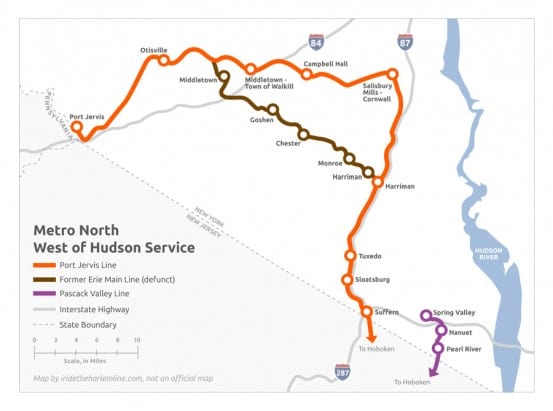
Map of the west-of-Hudson lines, including the former Erie main line that was abandoned in favor of the freight Graham Line.
Though us commuters on the east side of the Hudson don’t purposely try to forget our fellows over on the west, it is at times easy to ignore them. One pretty big reason is that their trains don’t run into Grand Central. Another reason is that the service is operated by New Jersey Transit. Although the stations are owned by Metro-North, and the railcars usually say Metro-North on the outside, the conductor you give your ticket to is a NJ Transit employee (and you probably bought that ticket from a NJ Transit TVM). The lines may end in New York state, but they begin in New Jersey.
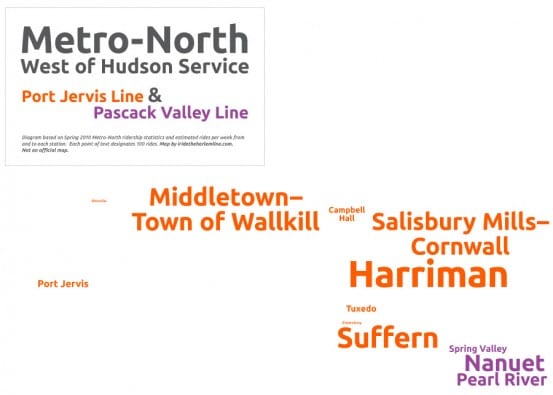
Ridership diagram of the west-of-Hudson lines, based on the number of rides to and from each station in an average week. Larger station names designate more rides.
However, one event in the past year has unfortunately brought news of the west-of-Hudson lines to the forefront. Last August’s impending Hurricane Irene led to an unprecedented shutdown of the entire MTA system, and although this helped significantly in mitigating damages, there were some places where it was unavoidable. After the storm had passed and the damage was surveyed, Metro-North was likely the worst hit, compared with the other MTA agencies. Although there was flooding at stations along the Harlem and Hudson Lines, it was the Port Jervis that bore the brunt of the storm’s fury. Service on the line was suspended indefinitely as washouts completely destroyed the track in some places, and entire parking lots were flooded. Photos of the damage became front page news – the Port Jervis Line had our attention – but for all the wrong reasons.
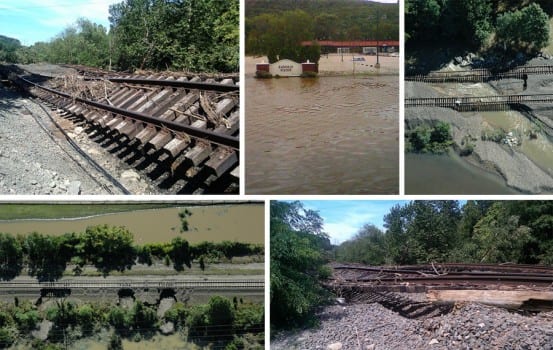
Selection of photographs showing the damage on the Port Jervis Line after Hurricane Irene. All photos from the MTA.
Aside from all that, the Port Jervis Line isn’t that bad a place. It is some of the most rural country on all of Metro-North’s territory, and riding a train through it all can be quite beautiful. My favorite part of the line, the Moodna Viaduct, I featured on the site several months ago. Most of the stations really aren’t much to write home about, but there are several former stations – like Middletown, and Port Jervis – which I also plan on showing you all.
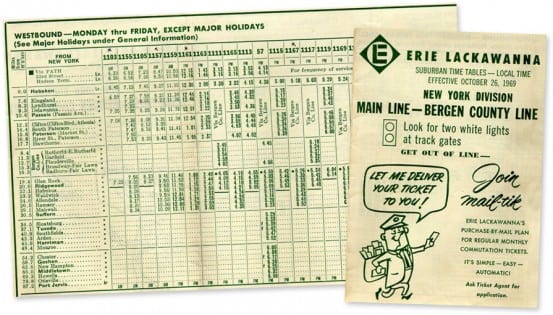
1969 Port Jervis main line timetable, which includes the line’s original passenger stations, until that part of the line was abandoned in the 80’s. From the collection of Michael Jensen.
Before we begin the tour next Tuesday with Suffern, I thought it would be good to mention a little bit of back story regarding the line. As I mentioned previously, none of the current stations (with perhaps the exception of Tuxedo) are really noteworthy – part of this is because the route the Port Jervis line now follows was not the original route for passengers. The original Erie main-line diverted west just after Harriman, and passed through Monroe, Chester, and Goshen, before meeting back up with what is the current line just after Middletown.
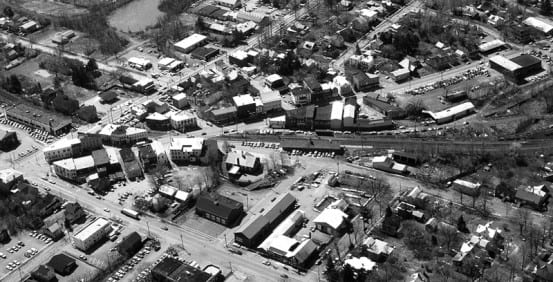
Aerial view of the Erie main line running through the town of Goshen. This portion of the rail line was removed in the 80’s.
The route the trains now follow was called the Graham Line, and was used mostly for freight. Instead of having to maintain two sets of tracks in roughly the same geographical area, a portion of the main line was abandoned in favor of the better-maintained Graham Line. This also meant abandoning several historical passenger stations (like the beautiful Erie depot in Middletown, now a library), and building new, relatively utilitarian, facilities on the former freight line. And instead of running right through the center of several towns, trains run on a more circuitous route outside of heavily populated areas.
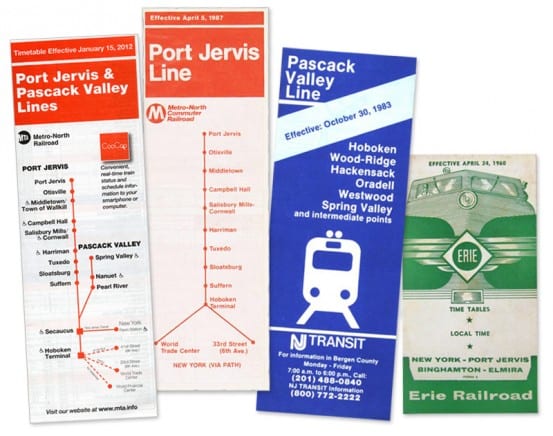
Other various area timetables, including the current combined Port Jervis and Pascack Valley timetable.
Since I have all of the Port Jervis stations photographed, I thought it might be nice to actually travel the line in order, starting with Suffern (which is really more of a New Jersey Transit station, though in New York state). Look for the Tuesday Tour of the Port Jervis Line, starting next week.


Truly a beautiful ride. I especially look forward to the inevitable (though short if you only do the three MN-owned stations) tour of the PVL, as that’s the line through my home town.
Yep, I am definitely going to do the 3 stations on the PVL too! Perhaps right after PJ, but I still have to get over there.
Whats new since last being at Port Jervis 2001 when I ived in Bergen County, NJ?
Any remains of the once bustling Erie/Erie-Lackawanna engine servicing area north of the station. Us to always have linch at the Burger King by teh RR bridge at Route 6 before crossing into PA.
Jerome of Bridgeport, CT
Emily, dear, you are awesome, as is your work. I worked driving trains on the nyc subway for 25 years. Worked the entire ststem.